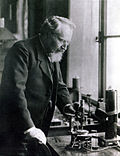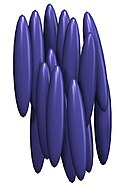Liquid crystal

Liquid crystals are special substances that are usually liquid, but that show certain properties of a solid crystal. A liquid crystal (LC) may flow like a liquid, but its molecules may be rotated in a crystal-like way. There are many different types of liquid crystal phases. Different phases are different because their optical properties are different. Using a microscope and a polarized light source, different liquid crystal phases will have different textures. This is also shown in the image.
The contrasting areas in the texture each correspond to a domain where the LC molecules are rotated in a different direction. Within a domain, however, the molecules are well ordered. LC materials may not always be in an LC phase (just as water is not always in the liquid phase: it may also be found in the solid and gaseous phase).
Liquid crystal displays use the optical properties of liquid crystals to control light.
Liquid Crystal Media
Chemical structure of cholesteryl benzoate molecule
Phase transition between a nematic (left) and smectic A (right) phases observed between crossed polarizers. The black color corresponds to isotropic medium.
A planar cell, filled with achiral LC host doped with an optically active Tröger base analog, placed between a pair of parallel (A) and crossed (B) linear polarizers. This doped mesogenic phase forms self-organized helical superstructures, that allow specific wavelengths of light to pass through the crossed polarizers, and selectively reflects a particular wavelength of light.








